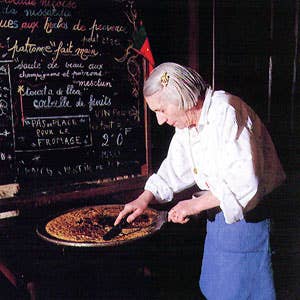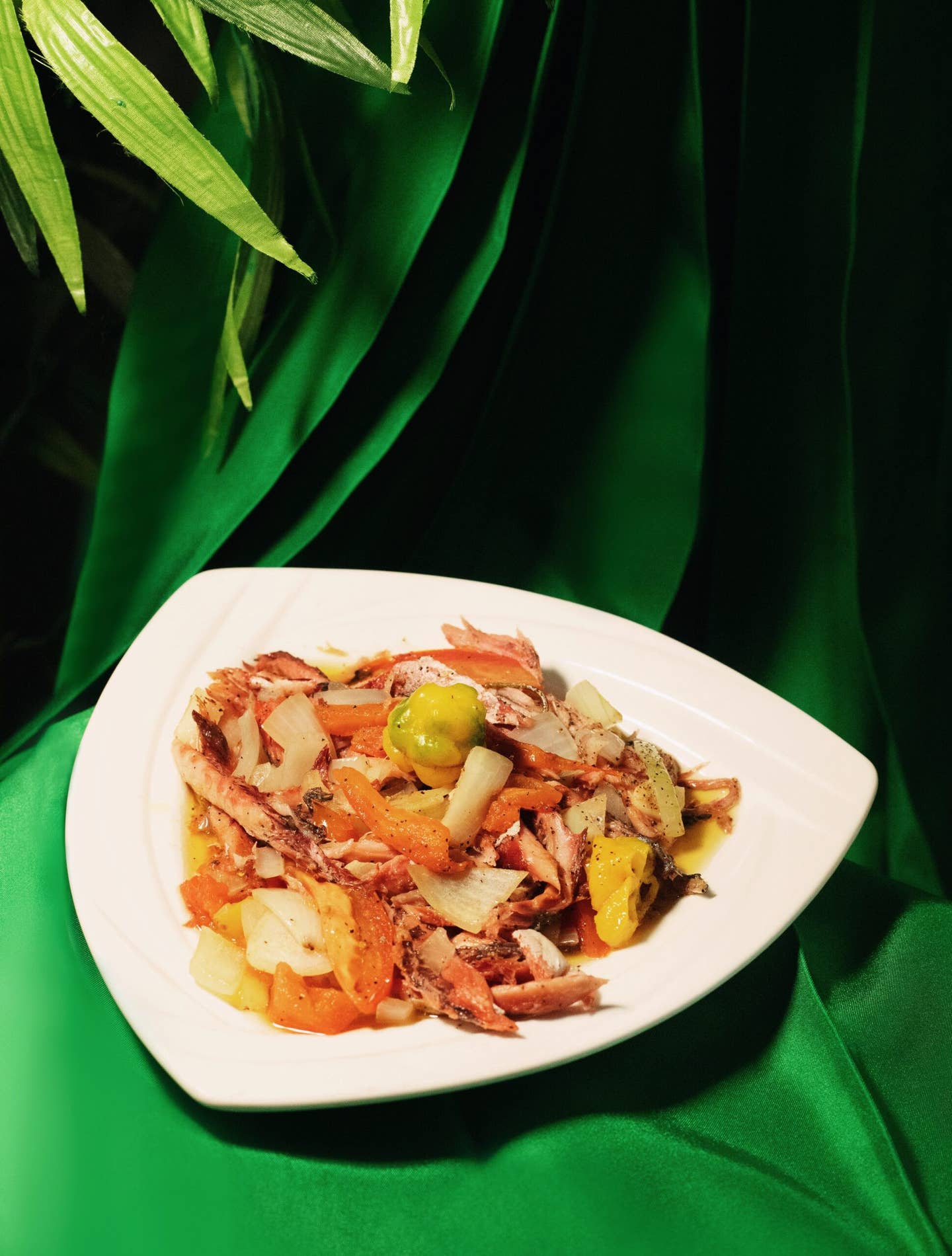
Secrets of Vieux Nice
One autumn evening in 1980, Catherine-Helene Barale welcomed me into the house where she was born, sat me down, and opened a whole world of food to me—a world in which I have since contrived to spend a good deal of time, both personally and professionally.
That she had played this role would come as a surprise to this charming but eccentric little woman in her eighties, with her wispy white hair and cockeyed smile. She was never consciously my culinary mentor. She doesn't even know my name. The next time I walk through the door of her restaurant near the Vieux Port in Nice, she won't remember me. But she will serve me almost exactly the same meal she has always served me and everybody else—the meal that introduced me, on my first visit to Nice, many years ago, to the intensely flavorful and often surprising cooking of this most seductive corner of the Mediterranean.
The restaurant called simply Barale or Chez Barale was once a farmhouse surrounded by fields. Cows grazed practically outside the door when she was a little girl, Barale told me one evening. Today, the fields have become apartment blocks, and Renaults and Fords now graze each other's bumpers where cows once ruminated. But Catherine-Helene Barale keeps Old Nice alive.
Her restaurant is an informal museum, chockablock with antique farm implements and rustic kitchen tools, and the nightly feast Barale offers is practically an encyclopedia of traditional Niçoise cuisine. There is no menu. The diner simply sits down to a procession of dishes: a wedge of crisp-crusted pissaladiere, a pizzalike tart topped with anchovy puree, onions, and salty Niçoise olives; a piece of socca, or chickpea-flour crepe, creamy in the middle, slightly charred on the edges; the real salade niçoise, with tomatoes, radishes, scallions, hard-boiled eggs, anchovies, and good tuna, but no lettuce and no cooked vegetables; a healthy helping of ravioli, filled with swiss chard—the defining vegetable of Nice—and ricotta cheese, moistened with daube de boeuf …
The main course is likely to be braised veal shoulder with mushrooms and sweet red peppers and a mesclun salad on the side. For dessert, there is a thick slab of tourte de blette, a sweet tart of swiss chard with raisins, pine nuts, and apples, with a sugar-dusted crust. Then comes a big bowl of fruit, and finally coffee and a tiny glass of marc with cherries in it. At the end of dinner, Barale passes out little folders bearing the words to a patriotic Niçoise anthem, "Nissa la Bella". She cranks up an ancient gramophone and thunks the needle down onto an old 78, and one and all—if they know what's good for them—lend their voices to rousing refrains of "E toujou criderai, / En la mieu ritournella / Viva, viva Nissa la Bella" [And always I'll proclaim, / Upon my return / Viva, viva, Nice the Beautiful].
After a meal like this—which is a revelation, a largesse, and a casually but shrewdly guided tour of the local gastronomic landscape, with all its simplicity and salt and savory intensity—it's hard to imagine anyone not wanting to join in.
Curving sensuously around the Baie des Anges, about 20 miles from the Italian border, Nice is the capital of the Cote d'Azur and the one of largest cities in France. It is an old city, spawned out of two pre-Christian settlements, one Greek and one Roman. The colony founded in the 4th century B.C. by Phocean Greeks from Marseilles, called Nikaia (for Nike, the goddess of victory), was the source of Nice's name.
Nice became part of France in 1860, the same year Italy was united into a nation—and thus, despite what a lot of folks will tell you, was never really "Italian". From 1388 until 1792 and again from 1814 until 1860, however, Nice belonged to the Turin-based House of Savoy and the Kingdom of Sardinia. Its Italianate flavor is thus palpable, especially in the sentimental heart of Nice, that part of the city's southeastern quarter that encompasses the Vieux Port, the little streets and squares of Vieux Nice, and the neighborhood of the jaunty Cours Saleya. Here, the architecture—much of it dating from the 17th and early 18th centuries—is baroque, the language has a peninsular accent (Nissart, a dialect of Provençal, is liberally peppered with Italian), and family names tend to end in vowels. Indeed, Vieux Nice resembles an Italian hill town more than a French village. Streets curve imperceptibly, overhung with narrow balconies, open shutters, flower boxes, laundry. Building colors are earthy but memorable—clay yellow, desert beige, the pink of a Mediterranean dawn. Little shops sell cheese, pasta, coffee, bread, wine.
Along one flank of Vieux Nice runs the Cours Saleya—a tile-paved promenade lined with cafes, restaurants, and shops. Here, six mornings a week, beneath gaily striped awnings—and at tables on the adjacent place Pierre-Gautier—one of the most famous flower and produce markets in France sets up.
The market changes, of course, with the season. In February, there are pears and apples, lemons and oranges, a few long-stemmed, leaf-wrapped baby artichokes and fava beans (from Spain or Italy, and expensive), and lacy clumps of frisee, their yellow-white interiors improbably bright. By early May, there are favas everywhere, artichokes galore, fat carrots, braids of garlic, deep green zucchini with brilliant orange flowers, asparagus in green, white, and inky purple. By midsummer, the market is bursting with cherries, peaches, melons, nectarines, tomatoes, peppers, even cascades of early mushrooms. In fall, the mushrooms have multiplied—cepes, girolles, pieds-de-mouton, pleurottes. There are pears and apples again, and heaps of cabbages and all their cousins. And always, year-round, there are herbs and cheeses and, above all, olives—the famous little local ones, plus an extravagance of imports, from elsewhere in France and from Italy, Spain, and Greece—black, green, purple, almost gray, almost red, and spicy, fleshy, sour, mild. Their perfume overwhelms even the tuberoses and the basil.
Nice is one of the few cities in France—Lyon is another—that can be said to have its own cuisine. Its ancient epic dish is estocaficada—an earthy ragout of slightly chewy stockfish (dried cod) with tomatoes, onions, potatoes, garlic, and olives. Poets wrote odes to estocaficada in the 19th century ("Gloria a tu, stocafic divin"); even today, natives of Nice forced to live elsewhere often fly home just for a fix of the stuff.
Other defining Niçoise dishes, besides those served by Catherine-Helene Barale, are the minestrone-like soupe au pistou (pistou is the local refinement of pesto), colorful farcis a la niçoise or petits farcis (assorted stuffed vegetables), meltingly tender tripe cooked with onions and tomatoes, beignets (fritters) of every kind, and the world-renowned ratatouille—the quintessential Mediterranean "vegetable medley".
Lovers of the local cuisine fear that it is on the verge of dying out. They cite as the villains "le fast-food", the homogenizing influence of television, and just plain changing times—which mostly means that the grandmothers who used to take the time to make this food are disappearing, and that their daughters and certainly their granddaughters (and grandsons) have other things on their mind.
For now, however, the visitor can still sample real Niçoise cooking, in forms ranging from the folkloric to the contemporary, in a handful of restaurants in the city.
Keep Reading
Continue to Next Story










